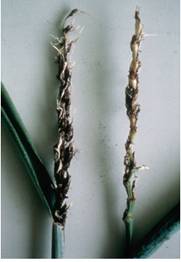Agricultural crops :: Cereals :: Wheat
Leaf Rust /Brown Rust-Puccinia recondita
| Symptom |
-
The postules are circular or slightly elliptical, smaller than those of stem rust, usually do not coalesce, and contain masses of orange to orange-brown Urediospores.
-
Infection sites primarily are found on the upper surfaces of leaves and leaf sheaths and occasionally on the neck and awns.
-
Survival : Both survive on stubbles and volunteer crops
-
Alternate host : Thalictrum sp.
-
Spread : uredospores from hills
|
|
| Life cycle of Puccinia recondita |
|
Stem Rust / Black Rust: Puccinia graminis f.sp. tritici
| Symptom |
-
Pustules (containing masses of urediospores) are dark reddish brown - occur on both sides of the leaves, on the stems, and on the spikes
-
Pustules are usually separate and scattered, heavy infections -coalesce.
-
Prior to pustule formation, "flecks" may appear. Before the spore masses break through the epidermis, the infection sites feel rough to the touch
-
As the spore masses break through, the surface tissues take on a ragged and torn appearance
-
Survival : Both survive on stubbles and volunteer crops
-
Alternate host : Berberis spp.
-
Spread : uredospores from hills
|
|
Stripe Rust /Yellow Rust-Puccinia striiformis
| Symptom |
-
The pustules of stripe rust, which, contain yellow to orange-yellow urediospores, usually form narrow stripes on the leaves.
-
Pustules also can be found on leaf sheaths, necks, and glumes.
-
Survival : Both survive on stubbles and volunteer crops
-
Alternate host : unknown
-
Spread : uredospores from hill
|
|
Loose Smut- Ustilago tritici
| Symptom |
-
The entire inflorescence, except the rachis, is replaced by masses of smut spores. These black teliospores often are blown away by the wind, leaving only the bare rachis and remnants of other floral structures.
|
|
| Life cycle of Ustilago tritici |
|
Updated on May, 2014
|








